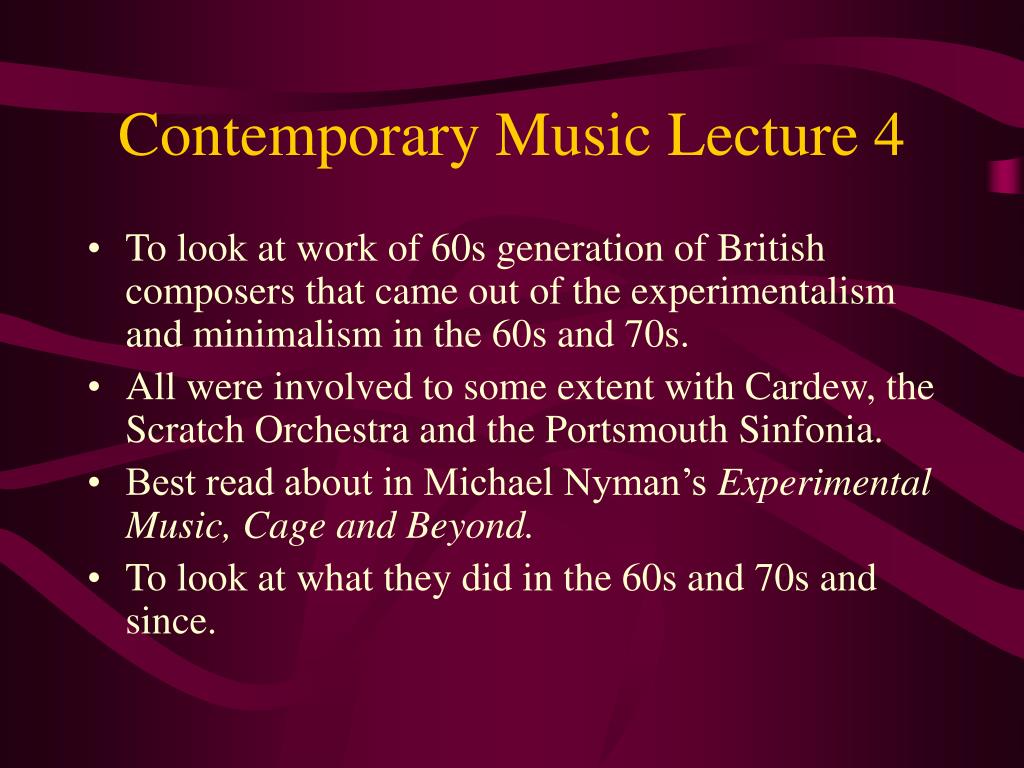Contemporary music is a dynamic and ever-evolving genre that breaks away from traditional musical conventions. It encompasses a wide range of sounds and styles from various cultures worldwide, making it a diverse and intriguing form of expression. With its complex time signatures, pitched percussion, electronic instruments, and lack of structure, contemporary music challenges the listener and pushes the boundaries of what is considered “normal” in music. It is an essential and integral part of today’s society, connecting people through its emotional depth and ability to transcend boundaries. By understanding and appreciating contemporary music, one can gain a deeper insight into the unique and ever-changing musical landscape of our time.
What period is contemporary music?
Contemporary music is a term that is often used to describe classical music created in recent times. While it is difficult to pinpoint an exact period for contemporary music, many musicians and listeners agree that it is heavily rooted in the 20th century. It was during this time that composers started experimenting with complex time signatures, rhythms, and melodies that didn’t always follow traditional tonal structures. However, contemporary music is not limited to any one genre and continues to be composed and performed to this day.
What are some characteristics of contemporary music?
Contemporary music is known for its complex and diverse characteristics. Some of the key features that define contemporary music include:
-
Complex time signatures: Contemporary music often incorporates time signatures that go beyond the traditional 4/4 or 3/4 time. It explores unconventional rhythms and meters, pushing the boundaries of what is considered normal in music.
-
Pitched percussion: Contemporary music utilizes a wide range of percussion instruments, including pitched instruments like triangles and maracas. This adds unique textures and tones to the music.
-
Electronic Instruments: With advancements in technology, contemporary music often incorporates electronic instruments and sounds. This allows for endless possibilities in terms of creating new and innovative sounds.
-
Lack of lyrics: While contemporary music can include vocal compositions, it is also known for instrumental pieces without lyrics. This allows the focus to be on the music itself and its expressive qualities.
-
Lack of structure: Contemporary music breaks away from traditional musical structures, such as predictable chord progressions or repetitive patterns. It embraces a more free and fluid approach to composition, allowing for experimentation and exploration.
-
Chromatic and atonal melodies: Contemporary music often features melodies that stray from traditional tonal structures. This can include atonal melodies, where the music lacks a key center, or chromatic melodies, which use all twelve notes of the Western music scale.
-
Variety in orchestration: Contemporary music incorporates a wide range of instruments and orchestration techniques. Composers often experiment with different combinations of instruments to create unique and expressive sounds.
-
Tonal, modal, and atonal music: Contemporary music encompasses a variety of tonalities, including traditional tonal music, modal music, and atonal music. This allows for a diverse range of sounds and styles within the contemporary music genre.
These characteristics make contemporary music a fascinating and ever-evolving form of expression.

How is contemporary music different from other types of music?
Contemporary music is distinct from other types of music in several ways. Firstly, it breaks away from traditional musical conventions and embraces experimentation and innovation. While genres like classical music have strict rules and guidelines, contemporary music allows for more freedom in terms of composition and performance.
Another key difference is the use of technology in contemporary music. With advancements in recording and production techniques, contemporary music often incorporates electronic instruments, samples, and digital effects. This gives composers and musicians the ability to create unique and immersive experiences for listeners.
Contemporary music also reflects the cultural and social context in which it is created. It often addresses current issues and reflects the experiences and emotions of the composer or performer. This makes it highly relevant and relatable to contemporary audiences.
Overall, contemporary music is characterized by its forward-thinking approach, embracing new technologies, pushing boundaries, and reflecting the ever-changing world we live in.
Importance of Contemporary Music
Contemporary music plays a crucial role in our society and holds great importance for several reasons.
Firstly, it represents the current musical landscape and serves as a reflection of the cultural, social, and political climate of the time. Contemporary music addresses relevant issues and expresses the emotions and experiences of both the composer and the listener.
Additionally, contemporary music provides a platform for creativity and innovation. It allows composers and musicians to experiment with new sounds, techniques, and genres, pushing the boundaries of what is considered music. This constant exploration and evolution contribute to the growth and development of the art form.
Moreover, contemporary music has a significant impact on popular culture. It shapes trends, influences other genres, and contributes to the overall diversity of the music industry. Many popular songs and artists today fall under the umbrella of contemporary music, further highlighting its importance and relevance.
Lastly, contemporary music serves as a means of expression and connection for individuals. It has the power to evoke emotions, provoke thought, and bring people together through shared experiences. Whether it’s a concert or a casual listen, contemporary music has the ability to create a sense of unity and solidarity among its listeners.
In summary, contemporary music is an integral part of our society, contributing to cultural expression, creativity, and connection.

Contemporary Music Composers
Contemporary music has seen the rise of numerous influential composers who have made significant contributions to the genre. Some of the most renowned contemporary music composers include:
-
John Williams: Known for his iconic film scores, John Williams has composed music for films like Star Wars, Indiana Jones, and Harry Potter. His compositions are characterized by grand orchestral arrangements and memorable melodies that have become synonymous with their respective films.
-
Philip Glass: A pioneering figure in minimalist music, Philip Glass is known for his repetitive structures and hypnotic compositions. His works span various genres, including opera, symphonies, and film scores.
-
Ennio Morricone: Renowned for his work in the film industry, Ennio Morricone composed music for iconic spaghetti Westerns like The Good, the Bad, and the Ugly. His scores are characterized by their strong melodies and incorporation of unconventional instruments.
These composers, among many others, have shaped the contemporary music landscape with their unique styles and contributions to various genres. Their works continue to inspire and resonate with audiences around the world.
Contemporary Music Genres/Types
Contemporary music encompasses a vast array of genres and styles from different cultures and regions. Some popular contemporary music genres/types include:
-
Blues: With its roots in African-American folk music, blues has evolved into a major genre of contemporary music. It features distinctive chord progressions, soulful vocals, and expressive guitar solos.
-
Hip Hop: Originating in the 1970s, hip hop is a genre characterized by rap vocals, electronic beats, and sampling from various musical sources. It has become a dominant genre in contemporary music and has influenced artists across different genres.
-
R&B (Rhythm and Blues): R&B combines elements of soul, funk, and pop music. It is known for its smooth vocals, catchy melodies, and emphasis on rhythm and groove.
-
Rap: A genre that focuses on spoken-word lyrics and rhythmic delivery, rap has become a prominent form of contemporary music. It often addresses social and political issues and showcases the creativity and prowess of its performers.
The genres listed above are just a few examples of the diverse range of contemporary music. From jazz to rock to electronic dance music, contemporary music continues to evolve and incorporate influences from various genres and cultures.

Summary
Contemporary music is a diverse and ever-evolving genre that encompasses a wide range of styles, techniques, and cultural influences. It is characterized by its departure from traditional musical conventions, embracing experimentation, and innovation. Contemporary music serves as a reflection of the social, cultural, and political climate of the time and has a significant impact on popular culture. It provides a platform for creativity and expression and brings people together through shared experiences. With its vast array of genres and artists, contemporary music continues to shape the musical landscape and captivate audiences around the world.
Learning
To further explore the world of contemporary music, here are two additional topics to delve into:
What Is Impressionism in Music?
Impressionism in music is a style that originated in the late 19th and early 20th centuries and is characterized by its emphasis on suggestion and atmosphere rather than precise musical forms. Inspired by the visual arts movement of the same name, musical impressionism seeks to evoke a mood or impression through the use of subtle harmonies, delicate melodies, and unique orchestration. Some notable composers associated with musical impressionism include Claude Debussy and Maurice Ravel.
What Is Tempo in Music?
Tempo refers to the speed or pace of a piece of music. It is indicated by a specific term, such as “adagio” (slow), “andante” (moderate), or “allegro” (fast), or by a specific beats per minute (BPM) marking. Tempo plays a crucial role in shaping the overall mood and feel of a musical composition and is often used to convey different emotions or musical styles. Understanding tempo is important for performing and interpreting music accurately and effectively.
By exploring these topics, you can deepen your understanding of contemporary music and its various elements. Happy learning!


